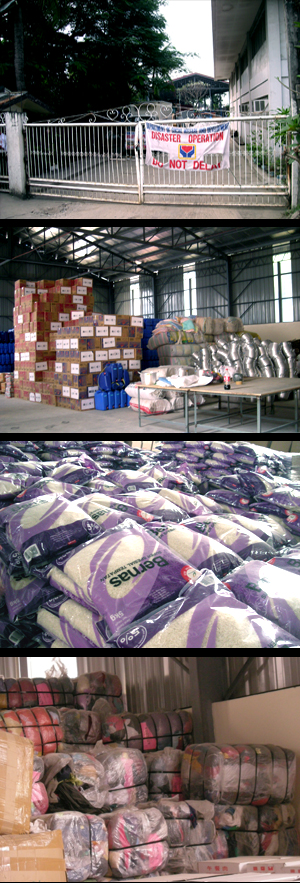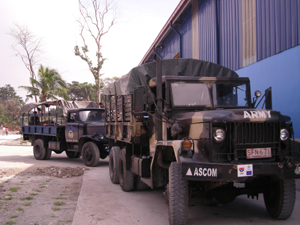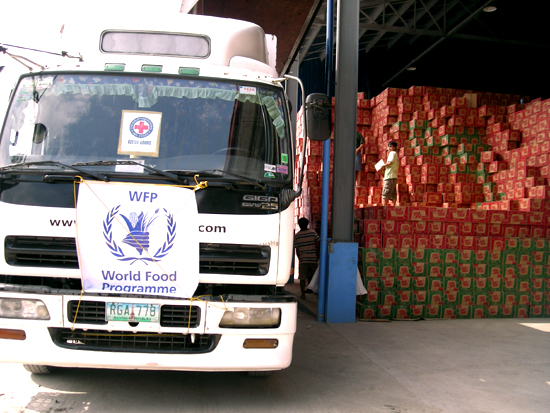
The DSWD's warehouses store relief goods ranging from imported rice to used clothing. Sophia Dedace
As if the onslaught from Ondoy and Pepeng were not enough, a barrage of criticism has flooded the Department of Social Welfare and Development for supposedly moving at a snail's pace in distributing relief goods to victims of the twin calamities. But in the wake of the controversy, life goes on inside the warehouses of the National Resource Operations Center of the DSWD – the center of public backlash after a blogger named Ella Rose delos Santos raised questions about the agency’s supposed inefficiency in dispatching relief goods last week. On Tuesday, DSWD staff members were busy loading trucks provided by the United Nations’ World Food Programme with boxes of instant noodles donated by the Indonesian government. In front of an adjacent warehouse, volunteers from the military loaded two trucks with sacks of relief goods intended for flood victims in Region 4-A -- the provinces of Cavite, Laguna, Batangas, Rizal, and Quezon. “We’re targeting to send about 27,000 sacks today," said Francia Fabian, warehouse manager of the DSWD-NROC. The goods will be sent to Camp Capinpin in Tanay, Rizal for distribution by DSWD employees to affected communities in the region. Each relief pack consists of three kilograms of rice donated by the WFP, canned goods from the Spanish Embassy, and instant noodles from a local food corporation. Another kind of relief pack, the “Pabaon Pack" from the United Nations Children’s Fund (Unicef), is intended for families that had to be relocated after flood waters inundated their homes. Inside are two plastic mats, a cooking pot filled with bath and laundry soap, a towel, a pack of sanitary pads, and a water jug stuffed with blankets.
Stockpiled goods At the DSWD’s NROC compound, there are four warehouses filled to the rafters with boxes, packages, and crates of relief goods. Two warehouses contain unsorted goods, another contains donated items that are in the process of getting sorted, while the last one holds relief goods that have been repacked and are ready for distribution. The NROC is the DSWD’s national storage facility for all the relief goods purchased by the government, as well as local and foreign donations. When the NROC receives donations, DSWD personnel make an inventory of the goods, classify and sort them before repacking the items based on the needs of beneficiaries. A staffer from the DSWD’s central office also inspects the goods and determines the monetary value of the donations received. DSWD’s inventory of relief goods received and released can be viewed
here and
here.

A Unicef "Pabaon Pack" includes two mats, a cooking pot loaded with 10 canned goods, 9 bars of bath soap, 5 bars of laundry soap, a towel, and a pack of sanitary pad, and an empty water jug stuffed with a blanket inside. Sophia Dedace
Fabian deplored insinuations from Internet users that the DSWD is setting aside foreign donations for other uses and only distributing local goods to typhoon victims. “Hindi totoo yung sinasabi na sini-set aside yung mga foreign donations para sa special kits kunwari," she said. Fabian also denied allegations that relief goods are being stockpiled for use in political campaigns in the 2010 elections. “Those are not true," Fabian said. "Walang halong pulitika dito." She said some foreign governments and organizations also donated goods bought in the local market. For example, the Spanish Embassy donated locally-made noodles.

BUSINESS AS USUAL. These DSWD workers who have been engaged in relief efforts for the past month say they are unfazed by the controversy that erupted after a blogger said the agency was inefficient. Sophia Dedace
In the
controversial blog entry titled “Aanhin pa ang damo kung patay na ang kabayo," delos Santos bewailed that the DSWD had been remiss in expediting the distribution of the goods. “The relief goods are not moving. By the way things look, they are not going anywhere. Hindi maglalakad mag-isa ang mga donations na ito papunta sa mga evacuation centers," delos Santos said.
HOW TO VOLUNTEER Gang Badoy, founder of RockEd Foundation, has taken it upon herself to organize volunteers to sort and repack DSWD relief goods – an unprecedented move for her group which has never worked directly with the government. Badoy said she started coordinating with DSWD Sec. Esperanza Cabral last Friday in the wake of the controversy caused by delos Santos' controversial blog. Without hesitation, Cabral agreed that RockEd volunteers help out in relief efforts at the NROC in Pasay City. According to Badoy, RockEd volunteers will hold shifts from 3 p.m. to 11 p.m. Monday to Friday. The civic leader shares that this was also the challenge she posed to those lashing against the DSWD to channel their anger into something more productive. "Ang daming nagco-complain and it has become a habit, perhaps an instinct, to bash the government. It’s easy to make the DSWD the villain. But there has to be action because we need to get the relief goods out," she tells GMANews.TV. "Personally, for now - I will be more than happy to help the government if that means more Filipinos get what's rightly theirs," she also quips in her blog. If you want to help, visit this pagefor more details. You may also want to sign up here if you want to volunteer. You can also check this schedule matrix prepared by Bayanihan Online. DSWD-NROC warehouse manager Francia Fabian says you do not need to be a RockEd volunteer to help out. “We welcome walk-in volunteers," she says. The DSWD-NROC is located at Chapel Road in Pasay City. It is near the Ninoy Aquino International Airport Terminal 2 (Centennial Terminal). Click here for the map. The blogger further adds: “Ano’ng ginagawa ng mga donations na ito sa warehouse? Apat na warehouse ang nasa loob ng compound na ‘yon! Apat na warehouse na punong-puno ng inaalikabok na relief goods. Relief goods na ayaw yata ibigay sa mga nasalanta. Halatang-halata." Delos Santos' statements sparked a firestorm against the government agency, prompting DSWD Secretary Esperanza Cabral to retort in a statement: “The relief goods don’t all go out at the same time and an empty warehouse is not proof that the goods were used properly, just as a full warehouse is not evidence that the goods are being hoarded." The blog post had elicited a flurry of angry reactions, especially from Filipinos abroad who had contributed to the relief efforts.
No shortage of volunteers? Fabian explained that their warehouses are still full of relief goods because of the continued influx of donations, but asserted that the agency is moving as fast as it can in getting them to the intended beneficiaries. “We have been working around the clock for a month already. Nakakalungkot lang na sinasabi na wala kaming ginagawa," she said. She admitted that some of their personnel had to take turns resting because of a low turnout of volunteers on some days, but denied that there is a shortage of people who can help repack the tons of goods stocked in their warehouses. On this slow Tuesday morning, however, it was evident that the DSWD could use some help in its relief operations. Less than 10 staffers were loading the WFP trucks with boxes of instant noodles. Still, Fabian insisted that they have sufficient manpower. “Marami akong staff na gumagawa. Tuloy-tuloy ang pagre-repack. It’s not an issue for us here na porke’t walang volunteers, nagiging slow ang operations."

Military trucks on Tuesday await relief goods intended for flood victims in Region 4-A. Sophia Dedace
Fabian claimed that the warehouses were not buzzing with activity on weekdays, but that “maraming volunteers sa gabi at pag weekends." Yet, it was unclear if the DSWD’s relief efforts are enough to reach the millions of people affected by Ondoy and Pepeng. In a statement last week, Cabral said her agency had distributed “500,000 food packs and 200,000 clothing packs as well as thousands of sacks of rice, blankets, beddings, and items of personal hygiene" since Ondoy and Pepeng ravaged communities in Metro Manila, in the Ilocos, Cagayan, Cordillera, Central Luzon, and Southern Luzon regions a month ago.

A truck from the World Food Programme is being loaded with boxes of instant noodles donated by the Indonesian government. Sophia Dedace
However, records from the National Disaster Coordinating Council (NDCC) show that more than nine million people have been affected by the twin calamities -- 4.75 million people from Ondoy and 4.47 million from Pepeng). As of October 27, there were still 14,892 families affected by Ondoy and 22,989 families affected by Pepeng residing in evacuation centers, the NDCC said. At the rate the DSWD is sending out relief goods, the numbers clearly show that it will take a huge increase in personnel and transport equipment for the agency to do its job well. If not delos Santos' blog, perhaps the figures of the multitudes still needing assistance can be a wake-up call for the DSWD to bolster its relief efforts. –
GMANews.TV 









